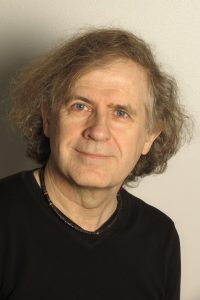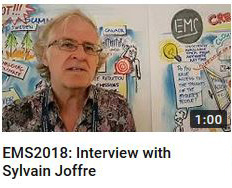Interview of the month: Sylvain Joffre
 Sylvain Joffre is the Chair of the EMS Committee on Meetings and the Programme and Science Committee for the EMS Annual Meetings
Sylvain Joffre is the Chair of the EMS Committee on Meetings and the Programme and Science Committee for the EMS Annual Meetings
Liaison Committee (LC): Good morning, Sylvain. Congratulations on successfully chairing the EMS CoM for many years. How long have you been on the committee?
I think I have been member of the EMS CoM since 2008 and have chaired the committee since 2014.
LC: Tell us a bit about your history working with EMS and conference planning. When did you start engaging in EMS conferences?
Actually, my involvement with EMS started, like many things in life, by chance. At the start of the millennium, I was deeply involved with the COST Organisation (European Cooperation in Science and Technology) as chairman of the Technical Committee for Meteorology and began trying to connect COST Action activities more tightly with the structured meteorological community. Around that time, the EMS Annual Meeting, jointly with ECAM and ECAC, was starting to become a feature on the European meteorology calendar (since 2000), so we tried to arrange sessions at the Annual Meeting for several COST Action activities. I acted as one of the conveners for a COST Action session at EMS2004. Since this was considered to be a success, and the subsequent networking with other EMS sessions was relevant, I continued to act as convener of a broader session with other colleagues. In 2007, I was asked to act as the Programme Group Chair (the equivalent of the current Programme Stream Moderator) for the ASI (Atmospheric System and its Interactions) Group of sessions, and then later to chair the CoM.
LC: What changes have you witnessed in conferences in general, and EMS conferences specifically, since you joined the CoM?
My active participation in scientific conferences stopped in the early 90s, when I was driven into governance with my involvement then confined to committee meetings for the most part. Based on my fluctuating experience during the past 40 years I think that the main changes have been that modelling activities have become more preponderant than empirical work, and application development work has diversified and intensified with its role increasing from being marginal to becoming as important as basic science. Of course topics have also evolved while interdisciplinarity has become more prominent and broader. For instance, in the late 70s and 80s, before I was directly involved with meteorology, acid rain and long-range transport was the major topic in atmospheric chemistry and air pollution. After 1985 stratospheric ozone depletion became the topic in the spotlight, followed by photo-oxidant and particulate pollution. Climate change was just a side topic. Now they have all merged into earth system science.
LC: Can you tell us about any particular highlights of your time in EMS?
Apart from many inspiring and seminal lectures by various speakers over the years, the main highlight, from the point of view of the role of the CoM in developing the Annual Meetings, was the implementation of the programme restructuring in 2017 which brought a new approach and framework. We moved from a disciplinary approach (based on climate, NWP, observations, and separate climate and weather applications) to an integrated and cyclic approach along the value-chain from R&D to applications and impacts driven by communication and societal demand.
LC: What do you think have been /are the biggest challenges you’ve experienced when developing the Annual Meeting further?

During the last 2 decades or so science and applications of meteorology have become anchored to an increasing number of social and economic activities. Thus, our main challenge while planning the Annual meeting is that we need to keep up with all these related developments in science but especially in socio-economical applications. This can be achieved by having adequate topical sessions and by anticipating emerging new topics and including such in the Annual Meeting. The other big challenge that goes hand-in-hand with the previous one, is to try to engage all players in the various aspects of the value-chain from observations and understanding to modelling and forecasting, and further on to applications, communication and decision-making. Although the Annual Meeting has a balanced attendance from academia, national meteorological services, research institutions, and communicators, the share from the private sector and manufacturers unfortunately still lags behind.
LC: Which new ideas are you, the CoM and the PSC pursuing at the moment?
Currently, the CoM and PSC are developing options to diversify the format of the Annual Meeting by letting some sessions mainly consist of keynote and broader contributions, and organising a mentoring event for young scientists. We are also developing a strategy for the Annual Meeting by defining and assessing the objectives of the Annual Meeting through its connection with current and emerging scientific and socio-economic incentives.
LC: How do you see the missions of the EMS?
The EMS is a network of networks since Members of EMS are not individuals but national meteorological societies together with national meteorological services, international organisations and private companies. As a consequence, I think that the EMS mission should not only foster interaction, communication and promotion of assets between all of its members, but also involve the broader community dependent on weather and climate (i.a. users, decision-makers and the general public). On the other hand, most of associate EMS members that are international organisations have only one type of membership (e.g. the membership of ECMWF and EUMETNET consists of meteorological services, and the membership of PRIMET consists of private companies). Therefore, EMS could act as a neutral forum for the broader community that deals with weather, climate and related disciplines, and could facilitate the development and strengthening of the impact and visibility of the meteorological community, e.g. through the Global Weather Enterprise initiative. This could be strengthened significantly by involving academia, since it represents one third of the attendees at the EMS Annual Meetings. On a broader scale, EMS could also contribute to promoting the achievements, roles and potential of the meteorological community for the benefit of society.
LC: Thank you very much for the interview!


Kommentare sind geschlossen.